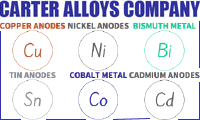
Curated with aloha by
Ted Mooney, P.E. RET

The authoritative public forum
for Metal Finishing 1989-2025

-----
Nickel and cobalt anodes
Our shop has a Ni-Co electroforming process and we are interested in using electrolytic cobalt like anodes. And we have one question: Is it possible maintain the cobalt in solution using electrolytic cobalt anodes connected to the same power supply alongside the nickel anodes?.
Thanks for you attention,
Henry Rodriguez- Guarne, Colombia
2003
You probably need to hire a literature search. Nickel and cobalt are so very very near identical that you might be able to use the same power supply and vary the number of anodes of each metal to keep the alloy deposition within a reasonable range. Problems, I doubt if you can buy sulfur depolarized cobalt chips, thus electrolytic.NOT great for electroforming. I would guess that you can not use SD nickel and electrolytic in the same tank and maintain the alloy balance within range even with two power supplies.
James Watts- Navarre, Florida
2003
First of two simultaneous responses --
James has hit one problem on the head - I too do not know where to get sulfur depolarised cobalt from, so you will have to take account of that in the bath formulation. This could affect the properties of the electroforming deposit. Secondly, cobalt is consumed from the electrolyte much faster than nickel is, so you will need to dissolve more cobalt than nickel. To do this, you will need to have each type of anode controlled by a separate rectifier and they will have to operate at different current densities, but with a common cathode. It is therefore theoretically possible to do what you want, but in practice it will be much more complicated and will need a lot of setting up and checking.

Trevor Crichton
R&D practical scientist
Chesham, Bucks, UK
2003
Second of two simultaneous responses -- 2003
James,
Your right. Using SD(sulfur depolarized)nickel and regular electronickel in the same basket is not good practice. The SD will dissolve preferentially and could cause uneven current distribution.
A few years ago I did a test using electrolytic cobalt as an anode in a bath of cobalt sulphate with no chlorides and the cobalt anode corroded fine so there would be no need for SD cobalt. That said, I think it would be difficult to get the anode ratio between nickel and cobalt right to get the desired alloy composition. I don't know that this could be calculated, it may require plain old trial and error.
Don Piett- Canada
First of two simultaneous responses --
I ran a cobalt line with chloride and electrolytic cobalt chips and plated 0.005 with no adhesion problem. But, electroforming is usually done from a sulfamate bath. Normally you are looking for an extremely low internal stress. Henry has not given us enough to really give him an answer. He may find an answer in literature. I do remember an article or two about 15 years ago. Alloy deposition is no piece of cake.
James Watts- Navarre, Florida
2003
Second of two simultaneous responses --
Cobalt will ALWAYS plate out faster than nickel. Cobalt plates out faster at lower current densities. Establishing a "balance" is probably impossible and definitely a life long R&D; program. Best advice, first question the accuracy of the interpretation of your instrument analysis that separates cobalt and nickel, then always be prepared to add Cobalt as concentrated Cobalt Sulfamate (and have it reliably analysed to separate nickel from cobalt).

Robert H Probert
Robert H Probert Technical Services
Garner, North Carolina

2003
adv.: Supplier of Copper Anodes, Nickel Anodes, Bismuth Metal, & Other Metal Products for Industry & The Arts

Q, A, or Comment on THIS thread -or- Start a NEW Thread
